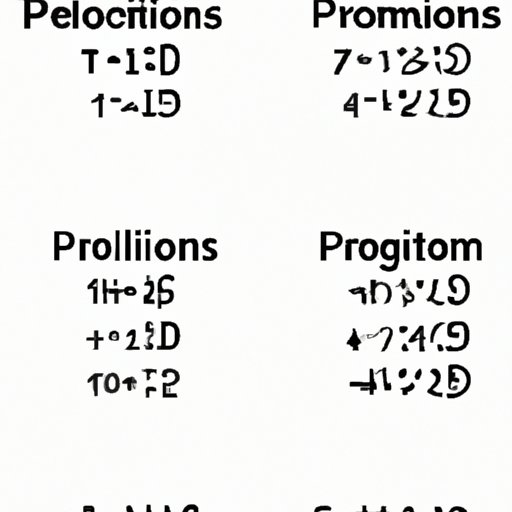
I. Introduction
Have you ever struggled with fractions in school or in your everyday life? Don’t worry; you’re not alone. Fractions can seem intimidating, but they’re actually essential in many aspects of life, from cooking and measuring to building and investing. The purpose of this article is to provide a step-by-step guide to mastering the basics of fractions. By the end of this article, you will feel comfortable identifying and simplifying fractions, mastering basic operations, visualizing fractions, and solving fraction word problems.
First, let’s start with the basics.
II. An Introduction to Fractions: Understanding the Basics
At its simplest, a fraction is a part of a whole. It represents a number that is not a whole number and is written in the form of one number over another. The top number is called the numerator, and the bottom number is called the denominator. The numerator represents the number of parts being considered, while the denominator represents the total number of parts the whole is divided into. For example, in the fraction 3/4, 3 is the numerator, and 4 is the denominator.
Fractions can be proper or improper. A proper fraction is when the numerator is smaller than the denominator. An improper fraction is when the numerator is equal to or larger than the denominator.
III. How to Simplify Fractions: A Step-by-Step Guide
Simplifying fractions means reducing a fraction to its smallest possible form. This is done by finding the greatest common factor, which is the largest number that can be evenly divided into both the numerator and the denominator. To simplify a fraction, divide both the numerator and the denominator by their greatest common factor.
For example, to simplify the fraction 24/36, find the greatest common factor of 24 and 36, which is 12. Divide both the numerator and denominator by 12, which gives you the simplified fraction of 2/3.
IV. Mastering Fraction Operations: Addition, Subtraction, Multiplication, and Division
Once you’ve simplified fractions, you can begin to master basic fraction operations like addition, subtraction, multiplication, and division. To add or subtract fractions, the denominators must be the same. If they aren’t, you need to find a common denominator. To multiply fractions, simply multiply the numerators and the denominators separately. To divide fractions, multiply the first fraction by the reciprocal of the second fraction. Cancel out any common factors before multiplying.
For example, to subtract 3/4 from 5/8, you need to find a common denominator. The common denominator for 4 and 8 is 8. Therefore, you need to rewrite both fractions with the denominator of 8. 3/4 becomes 6/8, and 5/8 stays the same. Then, you can subtract the numerators to get 5/8 – 6/8 = -1/8.
V. Visualizing Fractions: Using Shapes to Understand Numerators and Denominators
Visualizing fractions can be a helpful tool in understanding numerators and denominators. Using shapes, you can represent fractions. The numerator represents the number of parts shaded, while the denominator represents the total number of parts the shape is divided into.
For example, a circle divided into eight equal parts, with three parts shaded, can be represented as the fraction 3/8. A rectangle divided into 12 equal parts, with four parts shaded, can be represented as the fraction 4/12, which can be simplified to 1/3.
VI. Comparing Fractions: Finding Common Denominators and Equivalent Fractions
When comparing fractions, you need to find a common denominator. Once you have a common denominator, you can directly compare the numerators to determine which fraction is larger. You can also identify equivalent fractions, which are different fractions that represent the same value.
For example, to compare 2/3 and 5/8, you need to find a common denominator. The common denominator for 3 and 8 is 24. You can rewrite 2/3 as 16/24 and 5/8 as 15/24. Now, you can compare the numerators directly to determine that 2/3 > 5/8. Alternatively, you can identify that 2/3 = 16/24 and 5/8 = 15/24, which means they are equivalent fractions.
VII. Fraction Word Problems: Applying Fraction Concepts to Real-Life Situations
Fraction word problems are common in everyday life. For example, you might need to divide a cake into several pieces for a party or calculate how much paint is needed to cover a certain area. To solve fraction word problems, you need to identify the type of problem (e.g. sharing, dividing, measuring), set up the problem correctly using fractions, and solve the problem using the fraction concepts you have learned.
For example, if you need to share a pizza between three people, and each person should get 2/5 of the pizza, you can represent this as the fraction 2/5 x 3 = 6/5, which means you need 1 and 1/5 of the pizza.
VIII. Common Mistakes to Avoid When Working with Fractions
Working with fractions can be tricky, and there are some common mistakes you should avoid. These can include forgetting to simplify fractions, adding or subtracting fractions with different denominators without finding a common denominator, and making mistakes with signs.
To avoid these mistakes, you can practice your fraction skills regularly, double-check your work, and use different methods to approach problems.
IX. Conclusion
In conclusion, fractions can be intimidating, but they’re a crucial component of many aspects of life. By understanding the basics, simplifying fractions, mastering basic operations, visualizing fractions, comparing, and solving fraction word problems, you can improve your fraction skills and become more confident in using fractions. Remember to practice regularly, avoid common mistakes, and seek help when needed.




